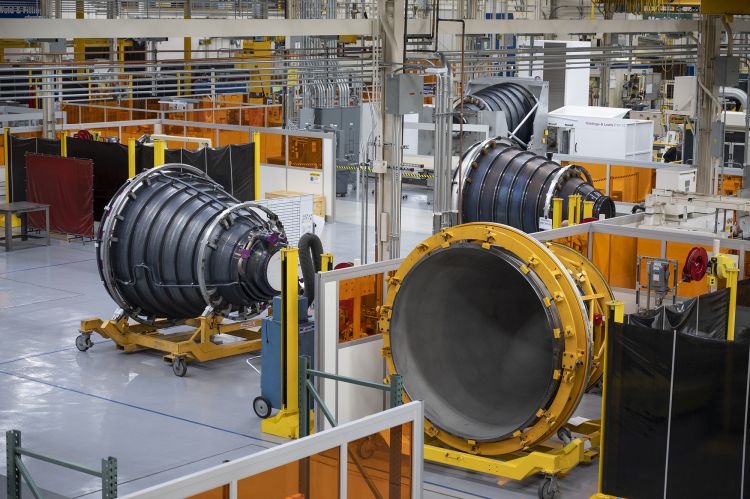
RS-25 nozzles in production at Aerojet Rocketdyne's Los Angeles, California facility.
February 8, 2023 - Aerojet Rocketdyne recently installed its new production nozzle on to the certification engine for the new batch of RS-25 engines that will help power NASA's Space Launch System (SLS) rocket, starting with the Artemis V mission. The new nozzle and certification engine are scheduled for their first hot-fire test on Feb. 8.
Only 16 engines remained from the shuttle program – enough for the first four Artemis missions to the moon, so new engines were needed. Aerojet Rocketdyne is currently building 24 new RS-25 production engines for missions Artemis V and beyond. This certification engine and a development engine will undergo hot-fire testing this year to verify the design for production.
"Engine development is historically the longest lead item in a new launch vehicle development program, and the SLS Program has benefited from having 16 engines remaining from the shuttle program," said RS-25 Program Director Doug Bradley. "Now, it's our team's turn to show how we can take the SLS rocket to the next level with these new, more affordable engines."
The new engines will operate at 111% rated thrust level, an increase from the shuttle program at 104.5% and the Artemis missions I-IV at 109%. Using new designs and manufacturing techniques, Aerojet Rocketdyne was also able to reduce the cost of the engines by 30% compared to the versions that flew on the space shuttle.
"The new engines have been enhanced for performance and most of the major components—like the nozzle, powerhead, main combustion chamber, turbopumps, valves and flex ducts—have been updated for efficiency and affordability," Bradley added. "After a 15-year production gap, our team has restarted production lines, qualified new suppliers, and diligently examined every piece of hardware on the RS-25 engine to see how it could be optimized while maintaining the engine's outstanding reliability."
The Aerojet Rocketdyne team has made tremendous strides in incorporating new methods, tools, and techniques into building this and future engines. For example, between nozzles one and four, the RS-25 team reduced tube stacking touch labor hours by 50%, beat their affordability target on the fourth nozzle by 17%, and reduced scrapped tubes on the fourth nozzle by 90% compared to the previous three.
In other areas, the RS-25 engine design was simplified from its shuttle heritage by using design solutions from the J-2X and RS-68 programs. By modifying the ducts that carry propellants from the SLS rocket to the turbopumps, the team saw a 62% reduction in cost for the ducts on RS-25. On the powerhead, which serves as the structural backbone to the RS-25, the team was able to eliminate 1,200 parts and reduce fabrication time of the first unit by 15%. The main combustion chamber is produced 22 months quicker with 71% less welds.
The certification testing will demonstrate the first major nozzle design update since the beginning of the shuttle era. Certification testing of the new RS-25 engine is on track to be completed in the fourth quarter of 2023, with new production engines slated to begin in 2024, well in advance of the Artemis program's need.

